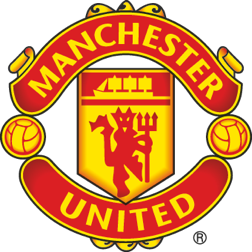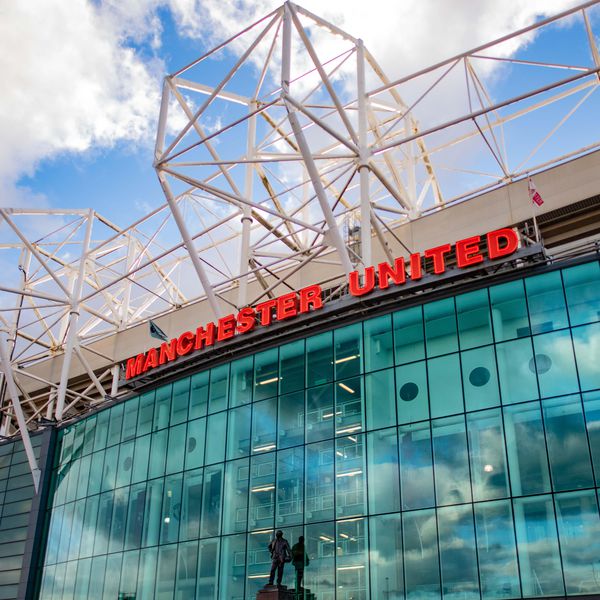Everything Sir Jim said about new stadium
Manchester United co-owner Sir Jim Ratcliffe has explained why the club has decided to pursue a new-build stadium, rather than redeveloping Old Trafford.
The decision was announced on Tuesday morning, as visuals and scale-models of the proposed venue, by Foster + Partners, were also revealed at an event in London.
MUTV's Harry Robinson was able to speak to Sir Jim about the developments and what the news means for supporters.
Scroll down to read Ratcliffe's answers on ticket prices, retaining the atmosphere and the future of United...
Sir Jim: New stadium will retain United’s soul
Sir Jim Ratcliffe explains the decision for a new-build stadium and his views around atmosphere and affordability…
Sir Jim, we’re at Foster + Partners, where the plans for a new Manchester United stadium have been announced. The following questions come from my perspective as a Manchester United fan and someone who stands in the Stretford End with my family and my mates. So the first one is: what's the decision to go for a new build rather than a redevelopment of a historic ground? Was that a hard one?
“Yeah, we spent a lot of time looking at the pros and cons of refurbishing the existing stadium, which has obviously got all the history of building a new stadium. And you know, it wasn't the easiest of decisions in a way, because, you know, the history of Manchester United is so important. But, ultimately, I suppose where we finished up was that we've got a ground at Old Trafford today, which is a bit piecemeal, isn't it? You know stadiums which were built or stands that were built at different times: they don't fit together very well. The roof leaks. It hasn't got the finest infrastructure. The players can't arrive underground and all that type of stuff. It's right next to the railway, which compresses the fans when they arrive, so we can't get people into the ground that easily and out of the ground.
“You know this expression: don't spend good money after bad. I think what would have happened if we tried to refurbish the stadium, we would have discovered that it actually would probably have been 70 per cent of the cost of building a new stadium. And in 25 years’ time, we'd be talking about building a new stadium because it wouldn't be perfect. So then we looked at the option of a new stadium and, of course, you can design the perfect stadium then - you can build a very large stadium.
“You can, you know, the access in and out, the sort of interesting things you can do around the stadium. Like you can build a museum, you can build shops, you could build a fanzone where people can watch matches, away matches, you know, with big screens and all that sort of stuff. Ultimately, it came down to, you know, what's the wisest way of spending Manchester United's money? Because at the end of the day, it's Manchester United's money that effectively will be behind it. We talked to lots of fans as well; they've obviously got a great sort of attraction and sympathy with that old ground. But, ultimately, I think what we were hearing was that, if this really was a fabulous, iconic new stadium, then they would accept that that was a good decision. So we did try to think about it from the fans’ point of view. That was the conclusion we came up with, that it would be a good way to invest money. And you know, we're not leaving behind the tradition and history of Manchester United. It's the same team that's going to be playing. And it's, you know, it's still got the same soul of Manchester United.”
What was the brief given?
“The brief to Norman Foster here was to build the world's most iconic football stadium. It had to be a stadium which was recognisable around the world. If you think today that the world's built a lot of new stadiums, hasn't it? You know, China for the Olympic Games and the Middle East and America, they've all built new stadiums and they're all fancy and quite impressive in their own right, but they all sort of merge a bit and you can't remember one from the other. They all look fancy. They're all circular or oval or whatever. But we said to Norman that we would like a stadium where when anybody in the world sees that stadium, they'll know it's Manchester United, that it's [unique], you know.
“The second part of the request was that it had to have a really intense atmosphere, and that the people in the stadium would be as close to the pitch as we possibly could achieve. So that means you've got relatively steep sides rather than flat sides. And we wanted an intense atmosphere because, at the end of the day, I think that's worth points in the league because the more intimidating it is from the point of view of just seeing this mass of people and the sound, because it's designed acoustically to reverberate, the better that is for the club.
“Because, at the end of the day, this is the club's ground. So we want to be winning matches at home and we want it to be a sort of fearsome atmosphere when the competing teams come in, so it really was about the best stadium in the world, the best stadium in Europe, better than the Bernabeu and the Nou Camp, which are both new and both really impressive, biggest in the world, intimidating. And, you know, everybody in the world would recognise it.”
In terms of atmosphere, the sceptics towards a new-build stadium will say that other clubs have moved into grounds and seen some of that rawness and some of that soul dissipate a little. So how has this project made sure that atmosphere is right at the heart of it?
“Because that's the sort of, in a sense, the number one objective in designing this ground. I've had a long conversation here with people about it's all about the atmosphere that we can generate in the stadium, the noise, the intimidation. You know, that rawness that you get in a great stadium and there’s absolutely no reason, in my view, why we can't achieve that. If you look at West Ham, they play in a stadium where you've got a running track around the edge of the pitch, so you know, they’re 20 metres from the edge of the pitch.
“We want the fans to be, you know, five metres from the edge of the pitch. And then we want, within obviously the legal constraints of design, we want a stadium that's relatively vertical and people are close in on the pitch. And I think, yeah, we will replicate the atmosphere that we've got at Old Trafford today. We will.”
United confirms ambition to build new stadium
ArticleSir Jim Ratcliffe, co-owner of Manchester United, said: “Today marks the start of an incredibly exciting journey."
One of the concerns for fans will be ticket prices going into a new ground. Is that a commitment from this early stage, that there will be affordable tickets? And could we even see a scenario where, because of the expanded capacity that the costs for the most loyal supporters might be subsidised by that expanded capacity?
“It's critical. I mean, this stadium is for Manchester United supporters and, you know, the majority of people who go to the ground are the people who live in Manchester and that community around. So the tickets have to be affordable and they have to be a fair price. So, you know, I fully support and understand that. And remember I was brought up on a council estate in Manchester. So it's not something that I'm incapable of understanding. I mean, that's where I started life - for the first 10 years of my life anyway. But there will also be seats that, you know, there'll be corporate entertainment, there'll be seats where, you know, people come from Hong Kong or people come up from London. They'll have to pay a bit more money for those, but we're going to look after the people in Manchester.”
For those fans as well, who have been going to Old Trafford for many years and have that tradition of going to the game and standing on the Stretford End… that has been passed down the generations. They will be sad to leave Old Trafford, regardless of how exciting any designs will be. So why, in your opinion, is such a big move worth it?
“I think I sort of get that and I understand that sort of attachment to the past. But really at the end of the day, I think for the fans, the single most important thing is that we win silverware, you know? I mean, what raises your spirits at the weekend is when we win football matches. If we lose a football match at the end, it sort of dampens your spirits, doesn't it? But we want to see the best footballers in the world winning football matches playing for Manchester United, and I think that's what we'll achieve with the new stadium. And I think that's more difficult in the old stadium.
“You probably saw the game on Sunday. The Arsenal match in the second half. I mean, that raised the spirits. I mean, that was a real fighting spirit, I thought, in the second half and the crowd really got behind the team and it really raised the spirits. Sport does that to you, and it's about winning. I mean, my only interest in Manchester United is that we get it back to the greatness, really to the place where it should be. You know, we all think of Real Madrid as being a fabulous team or Barcelona. We don't think about Manchester United in those terms at the moment. But we should be thinking about Manchester United in those terms. It should be one of the top three or four teams in Europe, and that's where I want to get United back to.”
‘The world’s best stadium’
GalleryTake a look at nine conceptual images of our proposed new home, courtesy of Foster + Partners.
So what is it about this design that Foster + Partners have put together? What's the bit that excites you the most?
“I think it's the scale of 100,000 people in a stadium. I've only ever been to one stadium with 100,000 people. That was the Nou Camp and I was there for the 1999 final against Bayern Munich. And I mean it’s a thing you can never forget because it's so impressive to be there among 100,000 fans screaming and shouting. I like design, it’s something that I enjoy in my life, and I think the design of the stadium is a 10 out of 10. I think it's a really special design that Norman Foster's inspired.”
What will be the process of consultation going from here, and will that include as well as fans and the local community, will that include the players perhaps, and their insights on what makes a winning first-team at a stadium?
“Well, I think we can. We've already spent quite a lot of time talking to fans and we know where the players are. I mean, they obviously want to play in the greatest stadium in the world, you know. So I think the consultation will continue, but I'd also like to get on with it because we can spend 10 years building a new stadium, or we can spend five years building a new stadium. And I'd rather spend five years then 10 years. I might not be here in 10 years!”
'The stadium can be built in five years'
ArticleLord Norman Foster outlines his vision for the centrepiece of Old Trafford's regeneration.
So what can Manchester United achieve? We're sat in front of a portrayal of what Carrington might look like in a few months’ time between this project and what happens next with an Old Trafford regeneration project. What do you envisage the future of Manchester United is in this new stadium?
“I just think it will return to greatness. It will be a great football club again. Carrington, I think, will be best in class. So we'll have one of the world's best training facilities. Again, Foster has done a great job at Carrington, so I mean it's quite sizeable. It's £50 million we've spent on that building. So it'll be a really impressive training facility that we have. There'll be no player at Manchester United who can ever say, well, you know, it's not as good as somewhere else. It'll be as good as anywhere. The stadium needs to be the same.”
Do you think about the first day at the new stadium and what you might feel on that day?
“Oh, I think it'll be like that 1999 final in the Nou Camp. You know, you can't sort of describe that feeling, can you? That elation in the last three minutes when we scored those two goals, it's going to be that sort of feeling I think – there are not many of those in your life.”




